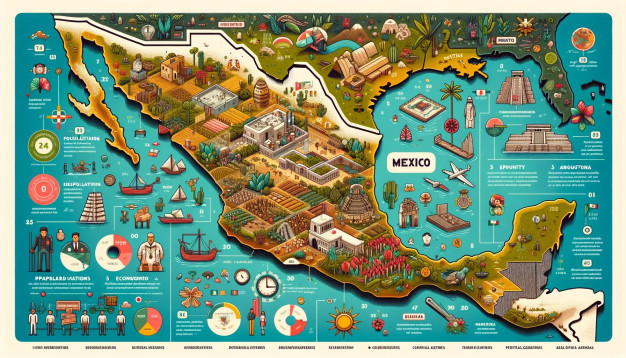
Introduction to Mexico
Mexico, the southern neighbor of the United States, is a country of contrasts and confluences. From the bustling streets of Mexico City to the serene beaches of the Riviera Maya, it’s a land where ancient civilizations, colonial history, and modern development dance a complex tango.
Mexico’s Demography
Population Distribution
Mexico sprawls over approximately 1.96 million square kilometers and is home to over 126 million people. Its population is mostly urban, with cities like Mexico City, Guadalajara, and Monterrey leading in density.
Ethnic Composition
A melting pot of indigenous, European, and mixed-heritage (mestizo) individuals gives Mexico a diverse ethnic composition. This mix provides a vibrant cultural fabric that’s as varied as the country’s landscapes.
Language and Culture
Spanish is the dominant language, but over 68 indigenous languages also echo throughout the land. The culture? It’s a fiesta of flavors, colors, and sounds with a side of historical depth that rivals the Mariana Trench.
Economic Overview
Major Industries
Manufacturing, oil, tourism, and agriculture keep the economic wheels turning. The country is also a maestro of silver production, so if you’re into bling, you’re welcome.
Trade and Investment
With free trade agreements, such as the USMCA, Mexico is a crucial player in international trade. Foreign direct investment flows in like margaritas on a Friday night.
Employment and Income Levels
Income levels vary widely, with high levels of inequality. The employment scene is a bit like a cactus – prickly and varied, with informal employment making up a significant portion.
Political Framework
Government Structure
Mexico is a federal republic with a president who’s both the head of state and government. Checks and balances? They’ve got them, with legislative power divided among the Union’s two chambers.
Political Parties and Elections
The major political parties include the PRI, PAN, and MORENA. Elections are a fiesta of democracy, though sometimes the hangover comes with allegations of irregularities.
Foreign Relations
Mexico plays well with others, especially its northern neighbor, the US, despite the occasional squabble over immigration and border walls. It’s an active member of international organizations like the UN and the OAS.
Population Growth and Challenges
Urbanization Trends
Rural-urban migration has turned cities into magnets. They’re growing faster than a teenager’s appetite, bringing a mix of opportunity and urban sprawl.
Health and Education
Public health and education systems face the challenge of accessibility and quality. They’re striving for improvement, like someone training for a marathon after a decade on the couch.
Social Inequalities
Income disparity, gender inequality, and limited social mobility are like unwelcome party guests who just won’t leave, hindering progress and social cohesion.
Cultural Richness and Heritage
World Heritage Sites
From the pyramids of Teotihuacan to the historic center of Oaxaca, Mexico boasts an impressive 35 UNESCO World Heritage Sites. It’s like a history buff’s all-you-can-eat buffet.
Traditional Cuisine
Mexican cuisine, a UNESCO Intangible Cultural Heritage, is more than tacos and tequila. It’s a gastronomic odyssey that’ll make your taste buds sing mariachi.
Festivals and Celebrations
Festivals such as Dia de Muertos and Semana Santa are a kaleidoscope of traditions that make Mardi Gras look like a quiet night in.
Environmental Issues and Efforts
Biodiversity and Conservation
Home to the Monarch Butterfly Biosphere Reserve and the Whale Sanctuary of El Vizcaino, Mexico’s biodiversity is its ecological crown jewel, sparkling brighter than a luchador’s mask.
Climate Change Impacts
Climate change looms like a dark cloud over a beach party, threatening coastlines, agriculture, and urban centers, forcing Mexico to adapt samba-style – gracefully but quickly.
Sustainable Development Initiatives
Green energy and sustainable tourism are like avocados – increasingly popular and vital for a healthy future. Mexico is embracing renewables, although it’s a long road from fossil fuels to clean energy fiesta.
Conclusion: Mexico’s Place in the World
Mexico’s tapestry of diversity, cultural wealth, and socioeconomic challenges makes it a unique player on the global stage. With one foot in tradition and the other in modernity, Mexico dances to a rhythm that’s all its own, inviting the world to lean in and listen.